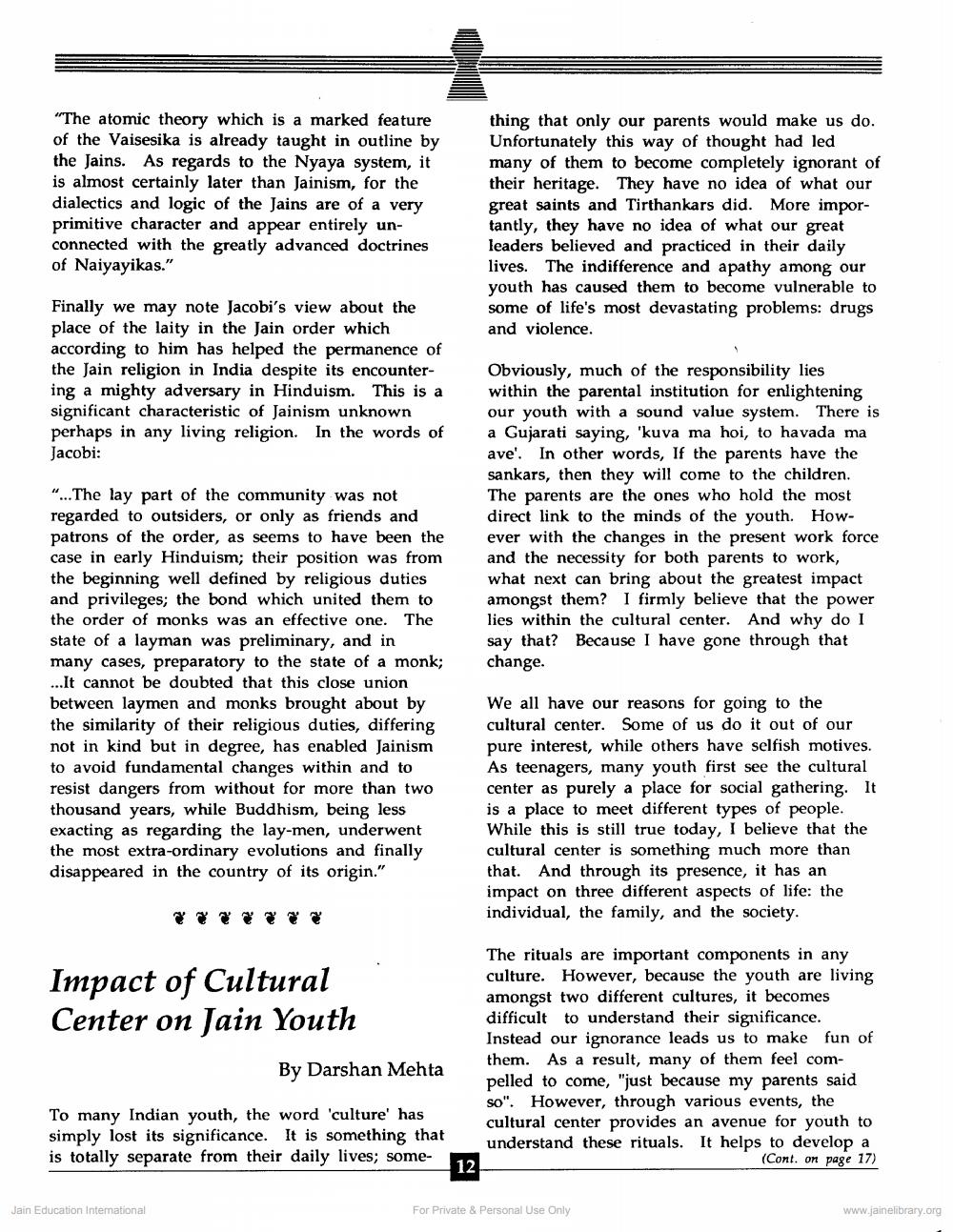________________
"The atomic theory which is a marked feature of the Vaisesika is already taught in outline by the Jains. As regards to the Nyaya system, it is almost certainly later than Jainism, for the dialectics and logic of the Jains are of a very primitive character and appear entirely unconnected with the greatly advanced doctrines of Naiyayikas."
thing that only our parents would make us do. Unfortunately this way of thought had led many of them to become completely ignorant of their heritage. They have no idea of what our great saints and Tirthankars did. More importantly, they have no idea of what our great leaders believed and practiced in their daily lives. The indifference and apathy among our youth has caused them to become vulnerable to some of life's most devastating problems: drugs and violence.
Finally we may note Jacobi's view about the place of the laity in the Jain order which according to him has helped the permanence of the Jain religion in India despite its encountering a mighty adversary in Hinduism. This is a significant characteristic of Jainism unknown perhaps in any living religion. In the words of Jacobi:
Obviously, much of the responsibility lies within the parental institution for enlightening our youth with a sound value system. There is a Gujarati saying, 'kuva ma hoi, to havada ma ave'. In other words, If the parents have the sankars, then they will come to the children. The parents are the ones who hold the most direct link to the minds of the youth. However with the changes in the present work force and the necessity for both parents to work, what next can bring about the greatest impact amongst them? I firmly believe that the power lies within the cultural center. And why do I say that? Because I have gone through that change.
"...The lay part of the community was not regarded to outsiders, or only as friends and patrons of the order, as seems to have been the case in early Hinduism; their position was from the beginning well defined by religious duties and privileges; the bond which united them to the order of monks was an effective one. The state of a layman was preliminary, and in many cases, preparatory to the state of a monk; ... It cannot be doubted that this close union between laymen and monks brought about by the similarity of their religious duties, differing not in kind but in degree, has enabled Jainism to avoid fundamental changes within and to resist dangers from without for more than two thousand years, while Buddhism, being less exacting as regarding the lay-men, underwent the most extra-ordinary evolutions and finally disappeared in the country of its origin."
We all have our reasons for going to the cultural center. Some of us do it out of our pure interest, while others have selfish motives. As teenagers, many youth first see the cultural center as purely a place for social gathering. It is a place to meet different types of people. While this is still true today, I believe that the cultural center is something much more than that. And through its presence, it has an impact on three different aspects of life: the individual, the family, and the society.
Impact of Cultural Center on Jain Youth
The rituals are important components in any culture. However, because the youth are living amongst two different cultures, it becomes difficult to understand their significance. Instead our ignorance leads us to make fun of them. As a result, many of them feel compelled to come, "just because my parents said so". However, through various events, the cultural center provides an avenue for youth to understand these rituals. It helps to develop a
(Cont. on page 17)
By Darshan Mehta
To many Indian youth, the word 'culture' has simply lost its significance. It is something that is totally separate from their daily lives; some
112
Jain Education Intemational
For Private & Personal Use Only
www.jainelibrary.org




